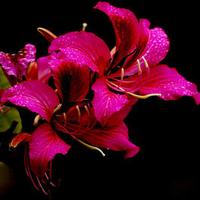红花 羊蹄甲
Safran-Krokus (Carthamus tinctorius)
Κόκκινο ανθισμένο πόδι του προβάτου
Safflower sheep's hoof
Pata de oveja de flor roja
le crocus à safran (Carthamus tinctorius)
赤い花のシープスフット
사프란 크로커스(카르타무스 틴토르투스)
Pata de carneiro de floração vermelha
шафранный крокус (Carthamus tinctorius)
红花羊蹄甲
各位 早安 。
Good morning to you.
おはようございます。
昨天 散步 的 时候 在 路边 看到 一种 长得 坏 坏 的 花 , 它 成功 勾起 了 我 的 好奇心 。
When I walked yesterday, I saw a flower that was bad and bad on the side of the road. It successfully evoked my curiosity.
J'ai vu une fleur gâtée sur le bord de la route quand j'ai marché hier, elle a réussi à éveiller ma curiosité.
昨日歩いたところ、道端に甘やかされて育った花があり、好奇心をそそられました。
于是 我 上网 查 了 一下 , 结果 又 一个 让 我 好奇 的 名字 —— 红花 羊蹄甲 。
So I checked it on the Internet, and the result was another name that made me curious - the red flower hoof.
倒 是 头 一次 听说 有花 叫 什么 羊蹄甲 的 , 在 好奇心 的 驱使 下 , 我 仔细 一看 , 原来 这 东西 居然 就是 紫荆花 。
For the first time, I heard that there is a flower called a hooves. Under the drive of curiosity, I took a closer look. It turned out that this thing was actually Bauhinia.
バウヒニアという花を聞いたのは初めてでしたが、好奇心に駆られてよく見てみると、実はバウヒニアであることがわかりました。
Это был первый раз, когда я услышал, что цветок называется Bauhinia. Под любопытством я посмотрел поближе. Оказалось, что это на самом деле Bauhinia.
红花 羊蹄甲 是 1880 年 在 中国香港 被 首次 发现 , 经 当时 港督 亨利 · 阿瑟 · 卜力 爵士 和 植物学家 共同 研究 , 确认 为 羊蹄甲 属 的 新品种 , 并 以卜力 爵士 的 姓氏 为 之 命名 , 原译 为洋 紫荆 。
The safflower hoof was first discovered in Hong Kong in 1880. It was jointly studied by the Governor, Sir Henry Arthur Buli, and the botanist, and confirmed as a new species of the genus Brahma. The name was originally translated as Bauhinia.
紅花バウヒニアは、1880年に中国の香港で最初に発見されました。当時ヘンリーアーサーバーリー卿と植物学者が共同研究した結果、バウヒニア属の新種であることが確認されました。この名前は、バーリー卿にちなんで名付けられました。名前はもともとバウヒニアとして翻訳されました。
香港 人 称为 “ 紫荆花 ”, 又 因 其 属 羊蹄甲 属 , 叫 它 “ 红花 羊蹄甲 ” 或 “ 紫花 羊蹄甲 ”。
The Hong Kong people call it "Bauhinia", and because of its genus, it is called "red flower hooves" or "purple hooves".
1965 年 , 红花 羊蹄甲 正式 被 定为 香港 市花 ,1997 年 后 中华人民共和国香港特别行政区 继续 采纳 紫荆花 的 元素 作为 区徽 、 区旗 及 硬币 的 设计 图案 。
In 1965, the safflower hoof was officially designated as Hong Kong City Flower. After 1997, the Hong Kong Special Administrative Region of the People's Republic of China continued to adopt the elements of Bauhinia as the design pattern of regional emblems, regional flags and coins.
昨天 我 get 到 这个 小 知识 的 时候 很 开心 , 你 呢 ?
I was very happy when I got this little knowledge yesterday, what about you?
昨日この小さな知識を得たとき、とても幸せでした、あなたはどうですか?

